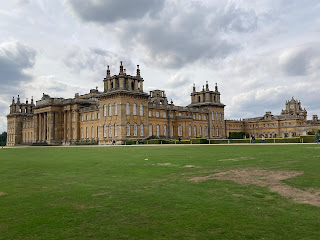Blenheim Palace
Blenheim Palace
Blenheim Palace, near Oxford, is the only non-royal, non-episcopal country house in England to hold the title of palace. It is the home to the current 12th Duke and Duchess of Marlborough and was also the birthplace of Sir Winston Churchill.
Blenheim Palace was presented by Queen Anne on behalf of a grateful English nation to John Churchill, the first Duke of Marlborough, in recognition of his victory in 1704 over French King Louis XIV at Blenheim in Bavaria. The Blenheim Tapestry shows the moment the French commander surrendered to that first Duke of Marlborough — absolutely dashing on his white horse with the carnage of war in the background.
The palace was designed by John Vanbrugh and Nicholas Hawksmoor in the nascent albeit eclectic and short-lived English Baroque Architectural style and was built between 1705 and 1722.
The magnificent structure sits majestically amidst a 2,100-acre undulating landscape sculpted from 1761 onwards to the designs of Lancelot "Capability" Brown, who earned the nickname for oft repeating the phrase, "this landscape has possibilities".
This visionary master landscaper constructed the twin Great Lake by first laying down humongous amounts of clay and flooding it for over a year by diverting the river Glyme. He also planted thousands of native trees in his ten-year tenure thereby engineering a landscape that appears natural but is actually contrived to please.
The first Duke of Marlborough was also awarded the title Prince of the Germanic Holy Roman Empire, as we are reminded by the double-headed Eagle Hapsburg crest in the Great Drawing Room [the Saloon] by Louis Laguerre (1719-20)
Over 90 acres of formal gardens were created over the centuries by esteemed garden designers such as Henry Wise and Achille Duchêne reflecting various styles through the different ages. These include the majestic Water Terraces, the Duke’s Private Italian Garden, the tranquil Secret Garden with all of its hidden treasures, the new Churchill Memorial Garden, and the beautifully delicate Rose Garden.
Sir Winston Churchill was born at Blenheim Palace in 1874. His blonde locks — first cut when he was five years old — hang above the bed. Grandson of the 7th Duke, he was also a close friend of the 9th Duke and Duchess. Although Winston spent a considerable amount of time at Blenheim Palace, especially for leisure, and proposed to his wife Clementine in the Temple of Diana, it is true to say it was never his home. Quite remarkable to think that the house of Churchill was responsible for the successful wartime leadership of the two most pivotal wars in the history of England, albeit two hundred years apart.
There was a curated exhibition of the paintings of Winston Churchill and Paul Lucien Maze, an Anglo-French painter. Paul, clearly the more accomplished artist of the two, is often known as “The last of the Post Impressionists" and was one of the great artists of his generation famous for his paintings of French maritime scenes, busy New York City scenes, and the English countryside.
As the affable and knowledgable American travel writer Rick Steves advised if there is one countryside noble palace you ought to visit in the UK, make sure it is Blenheim Palace. Glad we heeded his advice.
References
1. Blenheimpalace.com. 2022. Palace Homepage. [online] Available at: <https://www.blenheimpalace.com> [Accessed 23 September 2022].
2. Blenheim Palace. (2022, September 22). In Wikipedia. https://en.wikipedia.org/wiki/Blenheim_Palace
3. Centre, U., 2022. Blenheim Palace. [online] Whc.unesco.org. Available at: <https://whc.unesco.org/en/list/425/> [Accessed 23 September 2022].













Comments
Post a Comment
Please keep conversations courteous and on-topic. Kindly don’t engage in trolling, flame-baiting, name-calling, insulting, stereotyping or gratuitous attacks. Thank you for being a good citizen.